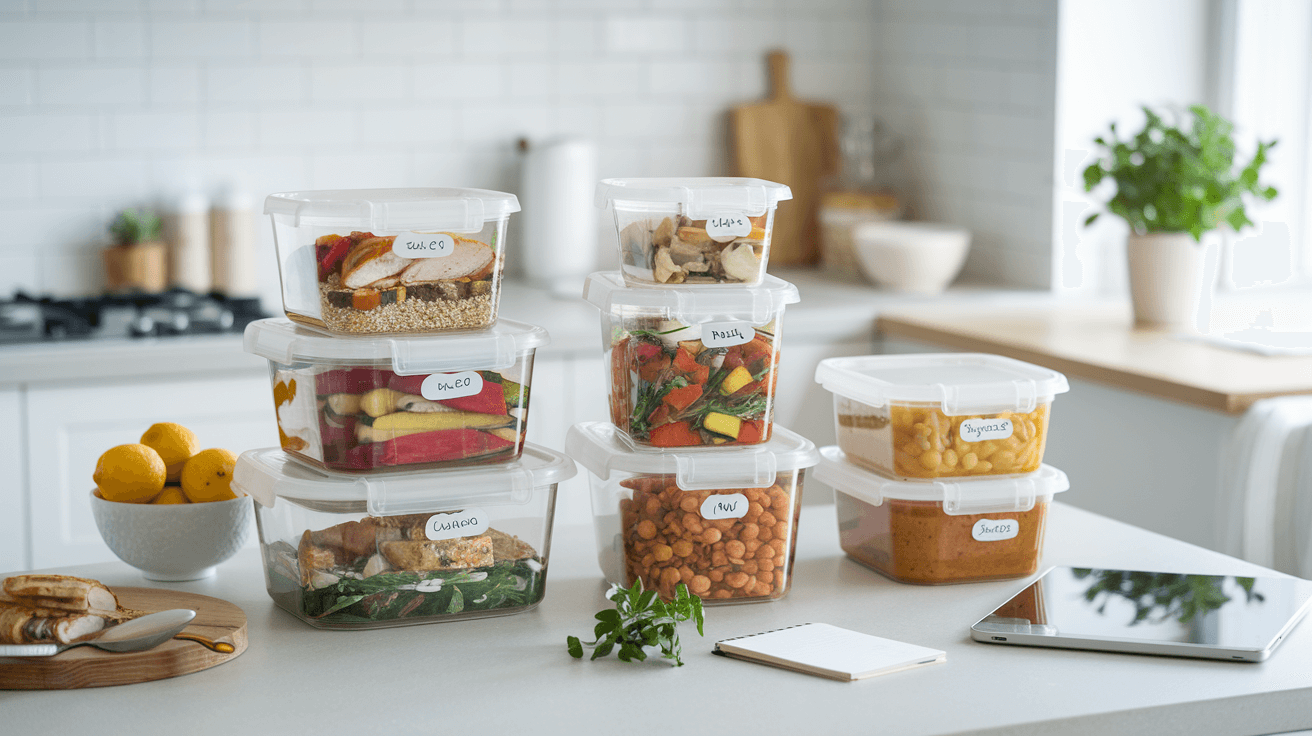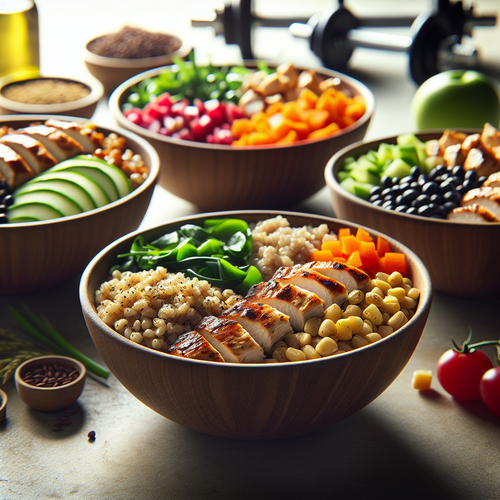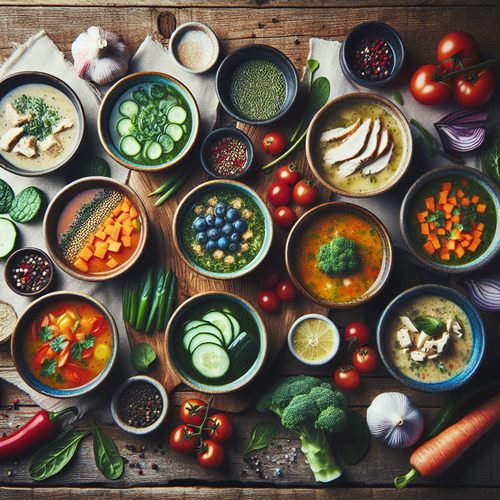The Definitive Blueprint to Healthy Freezer Meals for Weight Loss
Are you struggling to find the time to cook healthy meals, derailing your weight loss goals week after week? You’re not alone. In the constant battle between busy schedules and the desire to eat well, convenience often wins, leading to unhealthy takeout or processed foods.
This guide goes beyond simple recipe lists. It’s the definitive playbook for creating a sustainable, affordable, and science-backed freezer meal prep system that delivers results without sacrificing flavor or your precious time. We will provide a step-by-step prep method, a data-driven cost and health comparison of homemade vs. store-bought meals, and expert techniques to ensure your healthy freezer meals for weight loss are always delicious.
Table of Contents
- The ‘Why’: The Nutritional Foundation of Freezer Meals for Weight Loss
- The Complete ‘How-To’: Your Step-by-Step Freezer Meal Prep System
- Homemade vs. Store-Bought: A Data-Driven Comparison
- The Ultimate Recipe Toolkit
- Avoiding the Pitfalls: How to Make Your Freezer Meals Delicious
- FAQ: Your Freezer Meal Questions, Answered
- Conclusion
The ‘Why’: The Nutritional Foundation of Freezer Meals for Weight Loss
To successfully lose weight, you need a system that is both effective and sustainable. Freezer meal prepping isn’t just a convenience hack; it’s a strategic approach grounded in nutritional science that sets you up for consistent success. It addresses the core obstacles that derail most weight loss journeys: decision fatigue, time scarcity, and portion distortion.
How Freezer Meals Drive Weight Loss
The power of a well-executed freezer meal plan lies in automation and control. When you have a stock of nourishing, pre-portioned meals, you eliminate the daily guesswork and temptation. This system directly facilitates weight loss in two key ways:
Automated Portion Control: One of the biggest challenges in weight loss is managing portion sizes. A proper freezer meal prep for weight loss system forces you to portion everything out before you eat. By dividing meals into single-serving containers, you create automatic calorie control. There’s no risk of accidentally over-serving or going back for a second helping. This makes it easier to maintain a consistent calorie deficit, which is the fundamental requirement for losing weight.
Convenience That Prevents Poor Choices: After a long day, willpower is at its lowest. This is when the allure of fast food or high-calorie convenience meals is strongest. Having ready-to-heat low calorie freezer meals removes that friction. The healthiest choice becomes the easiest choice, effectively preventing impulse decisions that can sabotage a week’s worth of progress.
What Makes a Freezer Meal “Healthy”?
Not all freezer meals are created equal. The key to making this system work for weight loss is building your meals on a solid nutritional foundation. According to guidance from health experts like those at the Harvard T.H. Chan School of Public Health, a truly “healthy” meal focuses on nutrient density and satiety. For freezer meals, this means prioritizing three cornerstones:
- Low-Calorie Density: This means meals are rich in volume and nutrients but not in calories. Think lean proteins, fibrous vegetables, and whole grains. These foods fill you up without overloading your daily calorie budget.
- High Protein for Satiety: Protein is crucial for weight loss. It is more satiating than fats or carbohydrates, meaning it keeps you feeling full for longer. High protein freezer meals also help preserve muscle mass while you lose fat.
- Low Sodium and Whole Ingredients: Commercial frozen foods are often loaded with sodium and preservatives. Creating your own clean eating freezer meals gives you complete control over ingredients, allowing you to minimize sodium (which causes water retention and bloating) and eliminate unnecessary additives.
The Complete ‘How-To’: Your Step-by-Step Freezer Meal Prep System
Transforming your intention to eat healthier into a tangible reality requires a process. This playbook breaks down the entire system into manageable steps, moving you from planning to a freezer full of delicious, healthy meals.
Step 1: Planning & Shopping for Success
Success begins long before you turn on the stove. A solid plan is the difference between a chaotic, wasteful effort and an efficient, productive prep session.
- Choose Your Recipes: Select 3-4 recipes for the week. Start with simple, familiar dishes you know you’ll enjoy. To maximize efficiency, choose recipes that share ingredients (e.g., a chili and a taco bowl both use ground turkey, onions, and bell peppers).
- Create a Consolidated Shopping List: Instead of listing ingredients by recipe, create a master list organized by store section (Produce, Meat, Canned Goods, etc.). This prevents you from running back and forth in the grocery store and ensures you don’t forget anything.
- Shop Smart: Shop on a designated day when you have adequate time. Stick to your list to avoid impulse buys that don’t align with your goals. Opt for frozen vegetables and fruits where possible; they are just as nutritious as fresh, last longer, and are often cheaper, making your diy freezer meals for weight loss even more affordable.
Step 2: Batch Cooking & Prepping Techniques
This is where the magic happens. Dedicate a 2-3 hour block of time to your batch cooking session. An organized workflow is key to making this part of your freezer meal prep for weight loss feel manageable and even enjoyable.
- Set Up Your Stations: Designate different areas of your kitchen for specific tasks: a chopping station for vegetables, a cooking station at the stove, and a cooling/assembly station.
- Prep All Ingredients First: Before you start cooking, wash and chop all your vegetables, measure out spices, and open cans. This “mise en place” technique streamlines the cooking process.
- Cook in Stages: Start with the items that take the longest, like baking chicken or simmering a large pot of chili. While those are cooking, you can move on to quicker tasks like sautéing vegetables or cooking grains. This multi-tasking approach is essential for creating quick freezer meals for weight loss.
- Cool Food Completely: This is a non-negotiable step. Hot food placed directly in the freezer will raise the temperature, partially thaw surrounding items, and create large ice crystals that ruin the texture of your meal. Spread food on baking sheets or in shallow containers to cool quickly on the counter before transferring to the freezer.
Step 3: Food Safety & Storage Mastery
Proper storage is what preserves the quality, taste, and safety of your meals. Mishandling food at this stage can undo all your hard work.
- Use the Right Containers: Invest in high-quality, airtight, freezer-safe containers. Glass, BPA-free plastic, or reusable silicone bags are all excellent options. Ensure they are the right size for a single portion to aid in portion control.
- Label Everything: Every meal must be labeled with the name of the dish and the date it was frozen. This prevents “mystery meals” and helps you follow the “first in, first out” rule.
- Freeze Properly: Don’t overcrowd your freezer. Leave a little space between containers to allow cold air to circulate and freeze the food quickly. According to the USDA FSIS ‘Freezing and Food Safety’ guidelines, keeping your freezer at 0°F (-18°C) is essential for maintaining food quality and safety.
- Thaw Safely: The safest way to thaw your healthy freezer meals for weight loss is in the refrigerator overnight. For faster results, you can use the defrost setting on your microwave or submerge the sealed container in cold water, changing the water every 30 minutes.
Homemade vs. Store-Bought: A Data-Driven Comparison
One of the most common questions is whether it’s truly worth the effort to make your own meals when the supermarket freezer aisle is full of “healthy” options. A closer look at the data reveals a clear winner in terms of cost and nutrition.
The Cost Breakdown
The per-meal cost of commercial frozen dinners can be deceivingly high, especially when compared to the economy of scale you get with diy freezer meals for weight loss. Let’s compare a typical homemade chicken, broccoli, and quinoa bowl to popular store-bought options.
| Meal Type | Estimated Cost Per Serving |
|---|---|
| Homemade Chicken & Quinoa Bowl | ~$2.75 – $3.50 |
| Lean Cuisine (e.g., Herb Roasted Chicken) | ~$4.00 – $4.50 |
| Healthy Choice Power Bowl | ~$4.50 – $5.25 |
Note: Costs are estimates and can vary by location and retailer.
The Nutritional Showdown: Sodium, Preservatives, and Protein
The cost savings are significant, but the nutritional advantages are even more compelling. Commercial frozen meals, even those marketed as the best frozen meals for weight loss, often hide unhealthy amounts of sodium and lack sufficient protein to keep you full.
- Sodium: A typical store-bought “healthy” meal can contain 600-700mg of sodium, nearly a third of the recommended daily limit. A homemade version can easily be made with under 300mg. As the National Consumers League points out in their data-driven comparison of cost and nutrition, prepared foods often rely on high sodium levels for flavor and preservation, which can contribute to bloating and high blood pressure.
- Protein: Many low calorie freezer meals from the store skimp on protein, offering only 12-15g per serving. This isn’t enough to promote satiety, leaving you hungry again shortly after eating. A homemade meal can be easily packed with 25-35g of lean protein.
- Ingredients: By cooking yourself, you control everything. You use whole foods, healthy fats like olive oil, and no artificial preservatives, colors, or flavors—the definition of clean eating freezer meals.
The Convenience Factor: Is DIY Really Harder?
While store-bought meals offer instant convenience, a freezer meal prep system provides sustained convenience. Frame it this way: you are trading 2-3 hours one day a week for 15-20 minutes of saved time and mental energy every single day. No more daily “What’s for dinner?” stress, no last-minute grocery runs, and no time spent chopping and cooking every night. This system of creating quick freezer meals for weight loss is a time investment that pays dividends all week long.
The Ultimate Recipe Toolkit
Here are some simple, delicious, and freezer-friendly ideas to get you started, categorized to fit your specific needs.
High-Protein Power Meals
These meals are designed to maximize satiety and support muscle maintenance during weight loss.
- Turkey & Black Bean Chili: A classic that freezes beautifully. Packed with protein and fiber. Portion into individual containers for an easy, hearty lunch.
- Lemon Herb Chicken with Roasted Broccoli & Quinoa: A perfectly balanced meal. Cook chicken and quinoa, roast broccoli until slightly underdone, and combine in containers.
- Sheet Pan Fajita Bowls: Seasoned chicken or steak strips cooked with bell peppers and onions. Serve over cauliflower rice to keep it low-carb. These are fantastic high protein freezer meals.
Quick & Easy (Under 30-Min Prep)
For those who are truly short on time, these recipes minimize your active prep work.
- Sheet Pan Italian Sausage & Peppers: Chop sausage, bell peppers, and onions, toss with seasoning, and roast. The ultimate hands-off prep for quick freezer meals for weight loss.
- Hearty Lentil Soup: A “dump and go” recipe. Sauté onions and carrots, then add lentils, vegetable broth, and spices. Simmer and freeze.
- DIY Black Bean Burgers: Mash black beans with breadcrumbs, onions, and spices, form into patties, and freeze them uncooked between layers of parchment paper.
Vegetarian & Plant-Based Options
These recipes prove that you don’t need meat to create satisfying, protein-rich freezer meals.
- Chickpea & Spinach Curry: A flavorful and creamy curry made with coconut milk. It freezes exceptionally well and tastes even better after reheating.
- Quinoa-Stuffed Bell Peppers: Fill bell peppers with a mixture of cooked quinoa, black beans, corn, and spices. Freeze before baking for best results.
- Sweet Potato & Kale Bowls: Roasted sweet potato chunks combined with sautéed kale and a grain like farro. Add a tahini dressing after reheating. These are excellent vegetarian freezer meals for weight loss.
Perfectly Portioned for One Person
This category is perfect for individuals looking to control portions without waste.
- Mini Meatloaves: Use a muffin tin to bake individual meatloaves. They are perfectly portioned and freeze and reheat with ease.
- Individual Burrito Bowls: Layer rice, seasoned ground meat or beans, corn, and salsa in a single-serving container. Keep toppings like avocado or sour cream separate until serving.
- Single-Serving Lasagna Cups: Use wonton wrappers or lasagna noodles in a muffin tin to create mini lasagnas. These are ideal freezer meals for one person for weight loss.
Avoiding the Pitfalls: How to Make Your Freezer Meals Delicious
The biggest fear for many is that freezer meals will end up bland, watery, or mushy. With a few pro techniques, you can ensure your food tastes as fresh and flavorful as the day it was made.
Flavor First: Techniques to Keep Meals Tasting Fresh
- Be Bold with Seasoning: The freezing process can slightly dull flavors, so don’t be shy with herbs and spices during cooking. Garlic powder, onion powder, smoked paprika, cumin, and dried herbs like oregano and thyme hold up well.
- Undercook Vegetables Slightly: When making stews, soups, or roasted veggie bowls, cook vegetables until they are tender-crisp, not fully soft. They will cook a little more during the reheating process, resulting in a perfect final texture.
- Add Freshness After Reheating: The secret to vibrant healthy freezer meals for weight loss is adding a fresh component just before eating. A squeeze of lemon or lime juice, a sprinkle of fresh cilantro or parsley, or a dollop of Greek yogurt can completely transform a reheated meal.
Texture is Everything: Preventing the “Mushy Meal” Syndrome
Texture is just as important as flavor. The enemy of good texture is the formation of large ice crystals, which rupture the cell walls of food.
Know What Freezes Well (and What Doesn’t):
- Good: Soups, stews, chilis, cooked meats, grains (rice, quinoa), beans, and sturdy vegetables like corn, peas, and carrots.
- Bad: High-water-content vegetables like cucumber, lettuce, and raw tomatoes. Cream-based sauces and dairy can separate (though coconut milk holds up well). Fried foods lose their crispiness.
- Cool Food Completely: As mentioned in the prep section, this is the single most important step for preserving texture. Cooling food rapidly and completely before freezing minimizes the size of ice crystals, preventing that unappealing mushy consistency in your diy freezer meals for weight loss.
- Remove Excess Air: Air is the enemy of frozen food, causing freezer burn. Press out as much air as possible from freezer bags or use containers that are the right size for the portion to minimize empty space.
FAQ: Your Freezer Meal Questions, Answered
How long can you store healthy freezer meals?
For best quality, most cooked meals should be consumed within 2-3 months. While they may be safe to eat for longer according to USDA guidelines, their flavor and texture can decline over time. Always label with the date so you can keep track.
Do you cook meat before freezing it for meal prep?
Yes, for most meal prep systems, it is best to fully cook the meat. Dishes like chili, shredded chicken, or meatballs should be completely cooked, cooled, and then frozen. This makes reheating quick and easy. The exception is for “dump bags” (e.g., raw chicken and marinade) or items like uncooked burger patties.
What are the best containers for freezer meals?
The best containers are airtight, durable, and safe for both the freezer and microwave (or oven, if glass). Look for BPA-free plastic or borosilicate glass containers with locking lids. Souper Cubes or similar silicone trays are excellent for freezing soups and stews in perfect one-cup portions before transferring them to bags.
Conclusion
A systematic approach to freezer meal prep for weight loss is more than just a passing trend; it’s the most effective strategy for busy people to consistently achieve their health goals. By taking control of your ingredients, portions, and schedule, you create a sustainable system that makes healthy eating the path of least resistance. Homemade meals are not only significantly cheaper and more nutritious than their store-bought counterparts, but with the right techniques, they are also far more delicious.
Ready to take control of your health? Explore our full collection of high-protein freezer meal recipes to start building your first meal plan today.








